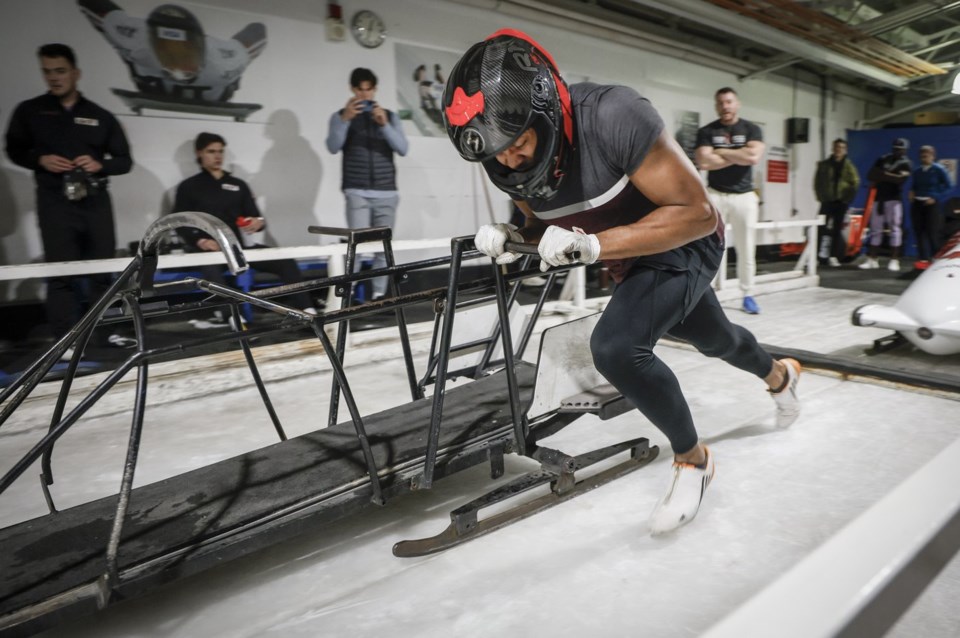CALGARY — Yohan Eskrick-Parkinson couldn't have imagined when his high school Halloween costume was a Jamaican bobsledder that he'd eventually intersect with that world of sleds and ice.
He grew up in Calgary diving competitively. He represented Jamaica at both the 2023 and 2024 world aquatics championships in a bid to qualify for the Olympic Games in Paris.
He didn't fulfil that dream, but another one has arrived quickly. At almost six-foot-two, Eskrick-Parkinson was unusually tall for a diver, but that frame gives him the potential power to push a bobsled.
After attending testing and push camps provincially and nationally in the summer and fall, Eskrick-Parkinson will slide down a track for the first time in his life Thursday in Whistler, B.C., with the goal of doing that for Canada at an Olympic Games.
"I'm just looking forward to it because it's another sport that's fast and it's aggressive on the body and that's what diving is like with flips and everything," said the 24-year-old.
"I've done all the levels of sport, except for the Olympics. And I thought, 'you know what? If there's a chance to go perform at that level or higher, again, I might as well take it and contribute.' And that's a huge opportunity that I can't deny."
Eskrick-Parkinson's father Desmond emigrated from Jamaica to Canada in the 1990s. His mother Melissa lived in Calgary during the 1988 Olympic Games. The underdog Jamaican bobsled team there inspired the 1993 movie "Cool Runnings."
Eskrick-Parkinson knew the story well while attending Calgary's National Sport School at WinSport, which was the site of the '88 sliding track.
"Cool Runnings was a big movie we watched pretty much every year of high school," he said. "There's a lot of connection there."
But his sport was diving until he retired earlier this year.
Eskrick-Parkinson competed for Alberta in the Canada Games in 2017 and in the Canadian junior diving championships in 2018 before joining Northwestern University's NCAA diving team for four years.
He felt his best chance at qualifying for Paris was in synchronized diving.
Jamaican diver Yona Knight-Wisdom was similarly tall, which Eskrick-Parkinson said made them a good synchro pair. The duo placed 13th at this year's world championship in Qatar.
Eskrick-Parkinson studied neuroscience at Northwestern. He's applied to medical schools while he pursues bobsled.
He was working out in a Calgary gym in the spring when Jamaican-born brakeman Lascelles Brown, who pushed Canada to two-man Olympic silver in 2006 and four-man bronze in 2010, suggested bobsled to him.
"I thought 'if I can adopt this mentality, this hard work and get big and get fast, maybe I can do it' because having him say that is a huge, huge honour," Eskrick-Parkinson said.
It's common for athletes from power sports such as track and field, rugby and football to graduate to bobsled.
A diving background might be unusual, but Eskrick-Parkinson says power is needed to launch from a springboard and his body awareness from diving's acrobatics can make him a fast learner in a different sport.
"I'm a really good jumper, and that's very related to running," he said.
"Diving is super technical. Every single dive we do, we're looking to our coach, and we do 60 to 100 dives a day. I can use the same process here, where I am going to push the sled, I'm going to get corrections, and I'm going to get better."
Bobsled pushing technique and how to load the sled on the run can be learned relatively quickly.
"I could tell he had an athletic ability just from his first few touches on the sled," said Eskrick-Parkinson's pilot Taylor Austin.
"He has already a mentality around high-performance training and high-performance sport, so I felt like it was an easy transition for him.
"You can tell he's been putting in the work. It's great to see that he's trying to take advantage of this opportunity that he has to to try a second sport and excel at it."
Eskrick-Parkinson's first run down Whistler's track will be a reckoning, however, as Austin says he's seen the odd athlete get on a plane and go home after their first time going 150 kilometres per hour down it.
Eskrick-Parkinson says years of centrifugal forces from spinning in the air might make that first slide less daunting.
"There's photos of me on the internet where I'm in a tuck position, hands on my shins flipping, and my face is just spread out because I'm just all stretched from the G-force," he explained.
"I'm anticipating the same thing. I'm sitting in that sled. My head's down, I'm tucked in, and I'm just going to be taking these corners."
This report by The Canadian Press was first published Oct. 29, 2024.
Donna Spencer, The Canadian Press




